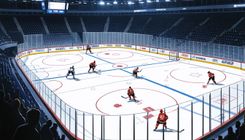NHL CBA Update: A New Path for Development

The current NHL collective bargaining agreement (CBA) is set to expire in September 2026. This impending date is of particular concern to those familiar with the sport's history, as it brings to mind previous labor disputes. However, this summer marked a noteworthy development, as NHL owners and the NHL Players Association reached an agreement on the framework for the new deal. Although the full Memorandum of Understanding has not yet been publicly released, NHL insider Frank Seravalli disclosed an intriguing change to come: starting with the new CBA, each NHL team will be permitted to assign one 19-year-old prospect to their AHL team each season. This policy, affecting a maximum of 32 players annually, has the potential to significantly alter the developmental landscape for NHL prospects.
Under the existing CHL-NHL agreement, prospects drafted out of Canadian major-junior leagues—specifically the OHL, WHL, or QMJHL—are restricted from being assigned to the AHL or ECHL until they either turn 20 or complete four seasons in the CHL. Meanwhile, players drafted from other junior leagues and later joined by a CHL team are exempt from this rule. While the changes will not take effect until the start of the 2026-2027 season, the first players this could potentially impact are those born in 2007. For instance, Vancouver Canucks prospect Braeden Cootes, who turns 19 in February 2026, may be assigned to the Abbotsford Canucks if it is deemed that the WHL is no longer the best environment for his development.
The age-based rule instead of draft year presents opportunities for freshly drafted CHL players who turn 19 shortly after the draft, allowing them to avoid returning to the CHL entirely. A noteworthy example is Ryan Roobroeck, a top prospect eligible for selection in 2026. As a September 2007 birthday, he could sign his entry-level contract and remain with his NHL team's development camp long enough to potentially be assigned directly to the AHL, bypassing a return to the Niagara IceDogs of the OHL. This new development path is critical for many CHL-affiliated prospects facing the predicament of being unprepared for the NHL but too advanced for junior leagues. This situation had previously hindered players like Dylan Strome, whose development was severely affected due to a lack of suitable options; had a path like this been available, his entry into the NHL may have been considerably smoother.
Recent examples illustrate this concept; Cole Perfetti played for the Manitoba Moose when the pandemic interrupted his junior season with the Saginaw Spirit in 2021. Similarly, Shane Wright received an exception to play with the AHL's Coachella Valley Firebirds in the 2023-2024 season, given his extensive OHL experience. Both players benefited significantly from participating at the AHL level rather than returning to the OHL or experiencing a full season away from play. Insiders describe the new regulation as allowing 'one player per organization per season', indicating that teams cannot regularly shift multiple 19-year-olds back and forth between junior and AHL teams in the same season. This restriction is unlikely to pose challenges, as it is uncommon for teams to have several standout 19-year-old prospects simultaneously competing for advanced development opportunities.
This policy presents substantial advantages for NHL teams eager to keep promising players closer to their organizations, enabling more direct oversight and development. Conversely, CHL teams may feel the adverse effects of losing top players to the AHL. The one-player limitation appears influenced by considerations from the CHL, as organizations would prefer to maintain access to their standout prospects. Additionally, while each NHL team can only assign one player per season, there is no stated limit on how many players can be drawn from each CHL team, heightening the stakes for teams with numerous strong prospects.
This development marks a potential setback for the CHL, compounded by recent changes related to CHL and NCAA eligibility rules. However, this particular setback may be mitigated if the implications of US President Donald Trump's executive order on NIL regulations are navigated favorably by educational institutions. Under this new arrangement, top CHL players can now transition into professional hockey a year earlier. This allows them to confront their weaknesses and leverage their strengths at the professional level rather than returning to junior hockey. Such a scenario could specifically benefit perennial powerhouse teams like the OHL's London Knights, whose players often miss the critical development that comes from overcoming challenges due to their consistent success.
Beyond the direct opportunities for players, there may also be unintended benefits arising from this policy shift. Scott Wheeler, a prospect writer for The Athletic, noted that numerous agents have suggested a preference among players for the CHL-to-AHL route, particularly in light of the uncertainty surrounding NIL opportunities. One CHL general manager remarked that, depending on the specific language of the CBA, players might secure their arbitration rights a year earlier through AHL assignments at 19, a significant incentive for many. This potential for gaining arbitration rights sooner is a noteworthy consequence of the rule change that players and agents will likely welcome, while NHL teams could find themselves apprehensive about its implications.
Additional advantages of transitioning from the CHL to the AHL include the benefits associated with signing bonuses and guaranteed salaries, enticing factors especially relevant amid the changing landscape of college sports and NIL considerations. For many young athletes who prefer not to return to an academic setting, this new route presents an appealing alternative to conventional pathways.









